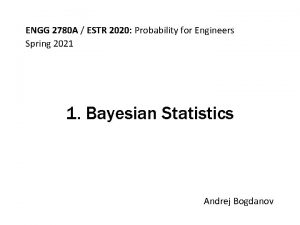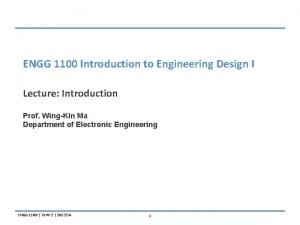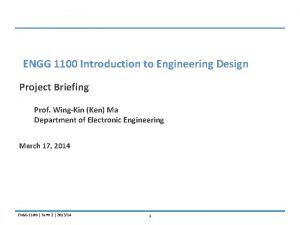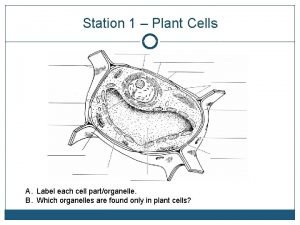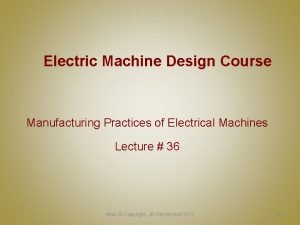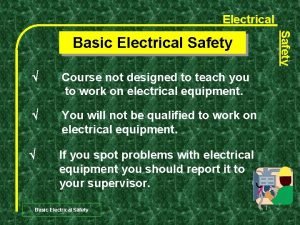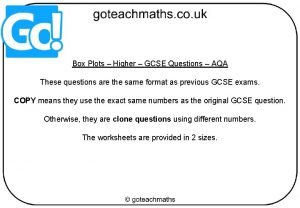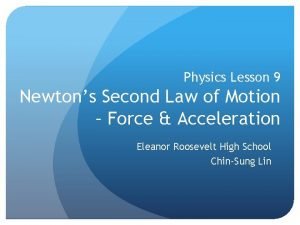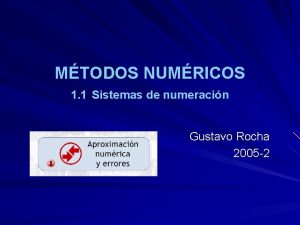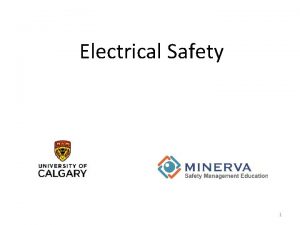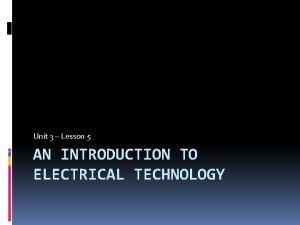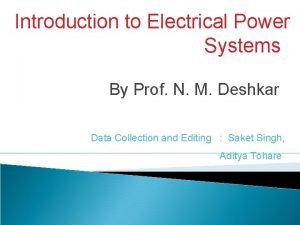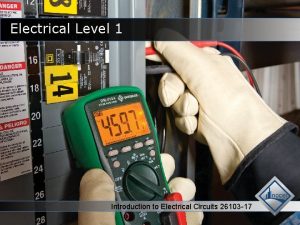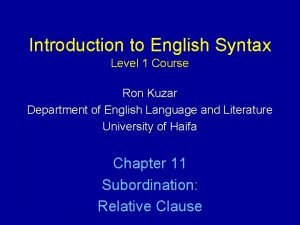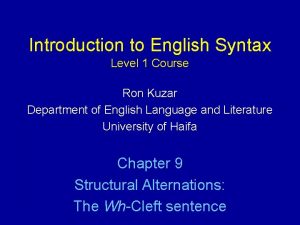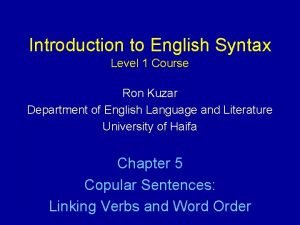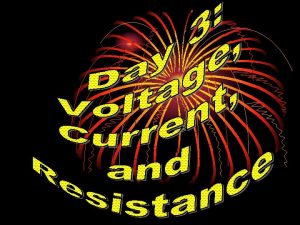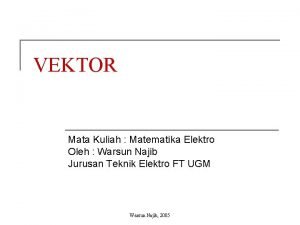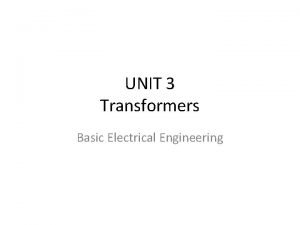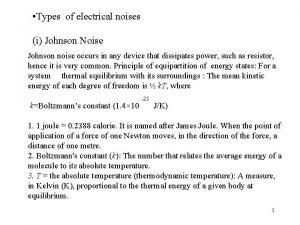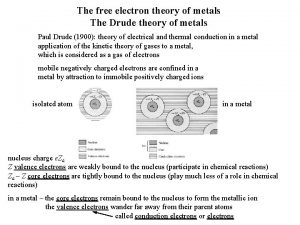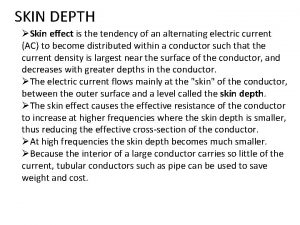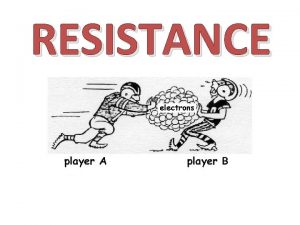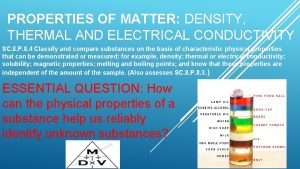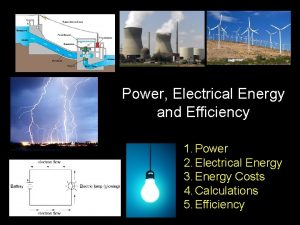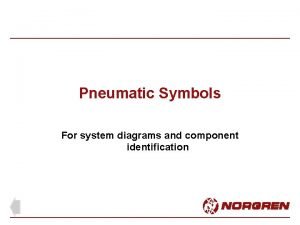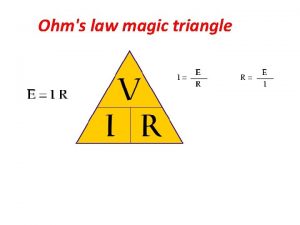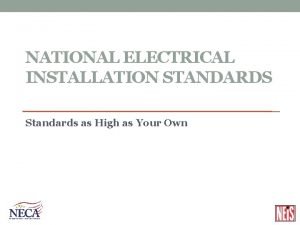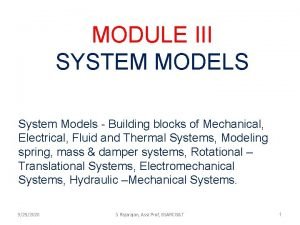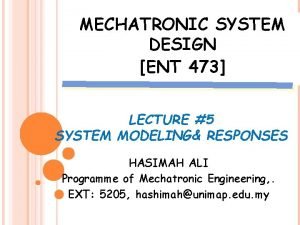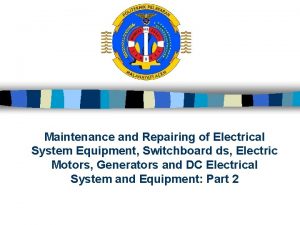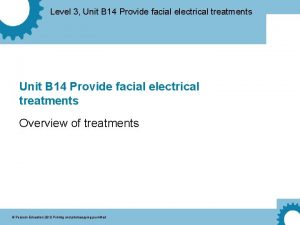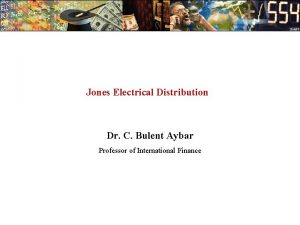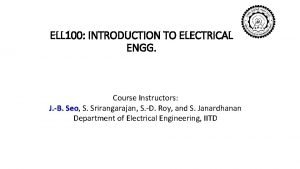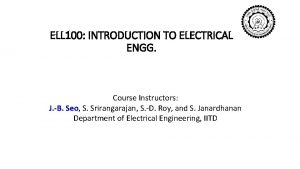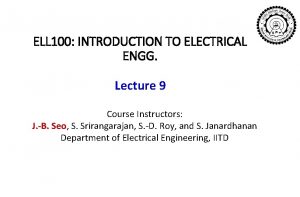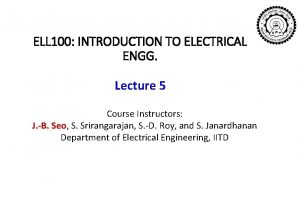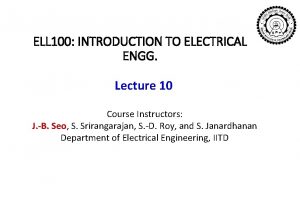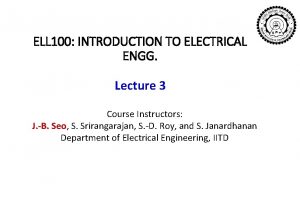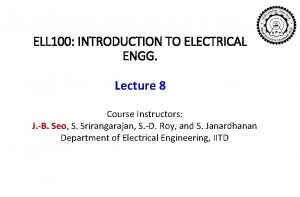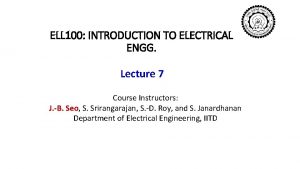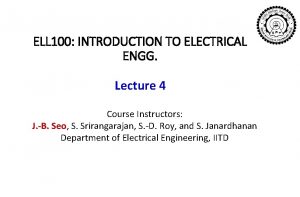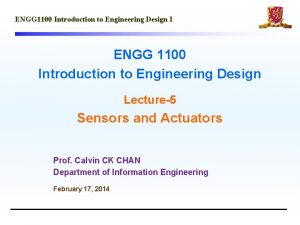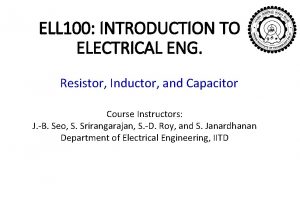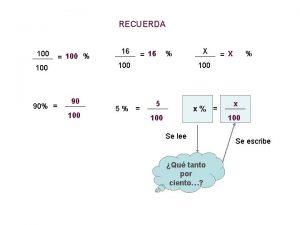ELL 100 INTRODUCTION TO ELECTRICAL ENGG Course Instructors


















































































- Slides: 82

ELL 100: INTRODUCTION TO ELECTRICAL ENGG. Course Instructors: J. -B. Seo, S. Srirangarajan, S. -D. Roy, and S. Janardhanan Seo Department of Electrical Engineering, IITD

Definition of magnetic field and force – 1 Magnetic flux density (unit: tesla, T, 1 T = 1 Weber/m 2) Magnetic flux, the amount of magnetic field

Definition of magnetic field and force – 2 Magnetic flux density (unit: tesla, T, 1 T = 1 Weber/m 2) Magnetic flux, the amount of magnetic field

Definition of magnetic field and force – 2 Magnetic flux density (unit: tesla, T, 1 T = 1 Weber/m 2) Magnetic flux, the amount of magnetic field

Definition of magnetic field and force – 3 Magnetic force on a moving charge and

Definition of magnetic field and force – 4

Definition of magnetic field and force – 4

Magnetization and hysteresis Cast steel or iron Magnetic field intensity Magnetic flux density:

Magnetization and hysteresis Magnetic field intensity Magnetic flux density: residual

Magnetization and hysteresis Magnetic field intensity Magnetic flux density:

Magnetization and hysteresis Magnetic field intensity Magnetic flux density:

Lenz’s Law Magnetic force by induced current pushes the incoming magnet.

Lenz’s Law Magnetic force by induced current pushes the incoming magnet. Magnetic force by induced current pulls the outgoing magnet. Induced I always flows to oppose the movement which started it.


Current coming toward you Current going away from you

Current coming toward you Current going away from you

Current coming toward you Current going away from you

Magnetically coupled circuit Mutual inductance (positive) turns Mutual voltage (Positive or negative)

Magnetically coupled circuit Mutual inductance (positive) turns Positive or negative

Dot convention turns

Dot convention

Dot convention

Dot convention

Dot convention

Write a mesh current equation Find and F

Write a mesh current equation Find and – +

Write a mesh current equation Find and + –

Write a mesh current equation Find and – + + –

Write a mesh current equation Find and

Write a mesh current equation Find and + –

Write a mesh current equation Find and – +

Write a mesh current equation Find and + – – +

Write a mesh current equation Find and

Write a mesh current equation Find and – +

Write a mesh current equation Find and – +

Write a mesh current equation Find and – +

Write a mesh current equation Find and – +

Write a mesh current equation Find and

Write a mesh current equation Find and – +

Write a mesh current equation Find and +

Write a mesh current equation Find and +

Write a mesh current equation Find and +

Coupling coefficient and energy stored

Coupling coefficient and energy stored

Coupling coefficient and energy stored • The energy stored in the circuit cannot be negative because the circuit is passive. Coupling coefficient

Ideal transformer is one with perfect coupling and no lossless coils: and The energy supplied to the primary must equal the energy absorbed by the secondary • The ratings of transformers are usually specified as . • A transformer with rating 2400/120 V should have 2400 V on the primary and 120 in the secondary (i. e. , a step-down transformer). The voltage ratings are in rms.

Ideal transformer is one with perfect coupling and no lossless coils: and The energy supplied to the primary must equal the energy absorbed by the secondary • The ratings of transformers are usually specified as . • A transformer with rating 2400/120 V should have 2400 V on the primary and 120 in the secondary (i. e. , a step-down transformer). The voltage ratings are in rms.

Ideal transformer is one with perfect coupling and no lossless coils: and The energy supplied to the primary must equal the energy absorbed by the secondary • The ratings of transformers are usually specified as . • A transformer with rating 2400/120 V should have 2400 V on the primary and 120 in the secondary (i. e. , a step-down transformer). The voltage ratings are in rms.

Ideal transformer is one with perfect coupling and no lossless coils: and The energy supplied to the primary must equal the energy absorbed by the secondary • A transformer with rating 2400/120 V should have 2400 V on the primary and 120 in the secondary (i. e. , a step-down transformer). The voltage ratings are in rms.

Ideal transformer

Ideal transformer

Ideal transformer We are interested in finding an equivalent circuit with an ideal transformer

Ideal transformer We are interested in finding an equivalent circuit with an ideal transformer Referred to the primary

Ideal transformer We are interested in finding an equivalent circuit with an ideal transformer Referred to the secondary Referred to the primary + –

Ideal transformer We are interested in finding an equivalent circuit with an ideal transformer (due to open circuit at a and b)

Ideal transformer We are interested in finding an equivalent circuit with an ideal transformer

Ideal transformer We are interested in finding an equivalent circuit with an ideal transformer The general rule for eliminating the transformer and reflecting the secondary circuit to the primary side is (given turns ratio is n): • Divide the secondary impedance by n 2 • Divide the secondary voltage by n • Multiply the secondary current by n.

Ideal transformer We are interested in finding an equivalent circuit with an ideal transformer The general rule for eliminating the transformer and reflecting the primary circuit to the secondary side is (given turns ratio is n): • Multiply the primary impedance by n 2, • Multiply the primary voltage by n, • Divide the primary current by n.

Practical transformer •

Non ideal transformer • The ideal transformer circuit can be modified to include the non idealities. § R 1 and R 2 are due to winding resistances in the primary and secondary. § X 1 and X 2 are inductance due to leakage flux. X 0 is due to the magnetizing flux. § R 0 is due to hysteresis and eddy current losses. § Typically the series elements have very small value, and shunt elements have very large values.

Non ideal transformer

Non ideal transformer

Non ideal transformer Referred to the primary

Non ideal transformer Referred to the primary

Non ideal transformer Referred to the secondary

Non ideal transformer • In open circuit test, the low voltage side is connected to a voltage source. • The high voltage side is open circuited. Rated voltage is applied. • Voltage, current and power are measured. V • A 20 k. VA 2500/250 V, 50 Hz single phase transformer gave the following test result: Open circuit test on low voltage (LV) side: 250 V, 1. 4 A, 105 W

Non ideal transformer • In open circuit test, the low voltage side is connected to a voltage source. • The high voltage side is open circuited. Rated voltage is applied. • Voltage, current and power are measured. V • This test estimates iron or core loss in a transformer • A transformer with 20 k. VA 2500/250 V, 50 Hz single phase transformer gave the magnetizing current VA rating following test result: § Open circuit test on low voltage (LV) side: 250 V, 1. 4 A, 105 W measurements

Non ideal transformer Core (iron) loss • A 20 k. VA 2500/250 V, 50 Hz single phase transformer § Open circuit test on low voltage (LV) side: 250 V, 1. 4 A, 105 W Power factor V (Full voltage on LV)

Non ideal transformer • A 20 k. VA 2500/250 V, 50 Hz single phase transformer § Open circuit test on low voltage (LV) side: 250 V, 1. 4 A, 105 W V

Non ideal transformer • A 20 k. VA 2500/250 V, 50 Hz single phase transformer § Open circuit test on low voltage (LV) side: 250 V, 1. 4 A, 105 W V

Non ideal transformer • In short circuit test, the low voltage side is short circuited. • Apply the voltage on the high voltage side to flow the rated current flow • Voltage, current and power are measured. (referred to the primary) Note that • We assume . and • This test estimates copper loss. and .

Non ideal transformer • The low voltage side of the transformer is shorted and voltage is applied to the high voltage side, because it only takes about 4%-7% of rated voltage to cause rated current to flow in the winding. • Transformer with 20 k. VA, 2500/250 V:

Non ideal transformer Copper loss • Short circuit test on high voltage side: 8 A, 104 V, 320 W and

Non ideal transformer • Short circuit test on high voltage side: 8 A, 104 V, 320 W and (Reduced high voltage)

Non ideal transformer • Short circuit test on high voltage side: 8 A, 104 V, 320 W and

Example • 2000 -VA, 230/115 V transformer has been tested to determine its equivalent circuit. The following measurements are taken the primary side of the transformer, i. e. , HV. 1) Estimate the parameters. 2) Find the equivalent circuit referred to the secondary (or LV side) • Open circuit test: Voc = 230 V, Ioc=0. 45 A, Woc=30 • Short circuit test: Vsc = 13. 2 V, Isc=6 A, Wsc=20. 1 Solution By using the measurements with open-circuit test, we get

Example • 2000 -VA, 230/115 V transformer has been tested to determine its equivalent circuit. The following measurements are taken the primary side of the transformer, i. e. , HV. Estimate the parameters. 2) Find the equivalent circuit referred to the secondary (or LV side) • Open circuit test: Voc = 230 V, Ioc=0. 45 A, Woc=30 • Short circuit test: Vsc = 13. 2 V, Isc=6 A, Wsc=20. 1 Solution By using the measurements with short-circuit test, we get

Example • Now, to find the equivalent circuit referred to the secondary, we use the following: and From and

Non ideal transformer • Efficiency,

Ideal transformer • The complex power in the primary winding is (in rms value) • Input impedance for the circuit with an ideal transformer: • This input impedance is called the reflected impedance, since it appears as if the load impedance is reflected to the primary side

Ideal transformer • The complex power in the primary winding is (in rms value) • Input impedance for the circuit with an ideal transformer: • This input impedance is called the reflected impedance, since it appears as if the load impedance is reflected to the primary side

Example • Find: (a) the source current , (b) the output voltage , and (c) the complex power supplied by the source.
 100 100 100 100 100
100 100 100 100 100 Engg2780
Engg2780 House civil engineering drawing
House civil engineering drawing Engg 1100
Engg 1100 Engg 1100
Engg 1100 Importance of edgar dale cone of experience
Importance of edgar dale cone of experience Social emotional needs of ell students
Social emotional needs of ell students Mcas accommodations
Mcas accommodations Ell 101
Ell 101 Plant ell
Plant ell Plant ell
Plant ell Stages of ell
Stages of ell Ell specialist
Ell specialist Karina ell
Karina ell Karina ell
Karina ell Karina ell
Karina ell Karina ell
Karina ell Karina ell
Karina ell Karina ell
Karina ell Karina ell
Karina ell Ell student profile
Ell student profile Electric machine design
Electric machine design Basic electrical awareness course
Basic electrical awareness course Basic electrical safety
Basic electrical safety T junction english bond
T junction english bond Course number and title
Course number and title Chaine parallèle muscle
Chaine parallèle muscle 180 nin yüzde 20'si
180 nin yüzde 20'si 200+200+100+100
200+200+100+100 Box plot gcse
Box plot gcse Malloc lab 100/100
Malloc lab 100/100 Héroïne dans la guerre de 100 ans (100 years war).
Héroïne dans la guerre de 100 ans (100 years war). 100+100=200
100+100=200 Big data on bare metal
Big data on bare metal 200+200+300+300
200+200+300+300 C/100=f-32/180=k-273/100
C/100=f-32/180=k-273/100 What's 100 + 100
What's 100 + 100 300+300+200+200
300+300+200+200 Los numeros romanos 1000
Los numeros romanos 1000 200+200+300+300
200+200+300+300 How electricity works
How electricity works Electrical safety introduction
Electrical safety introduction Lesson 5 introduction to electrical devices
Lesson 5 introduction to electrical devices Introduction to electrical power systems
Introduction to electrical power systems Nccer introduction to electrical circuits
Nccer introduction to electrical circuits Introduction to banking course
Introduction to banking course Imbe introduction course v2
Imbe introduction course v2 Introduction to software engineering course outline
Introduction to software engineering course outline Ron had a course introduction
Ron had a course introduction Cleft sentences example
Cleft sentences example Ron had a course introduction
Ron had a course introduction Introduction to psalm 100
Introduction to psalm 100 Introduction paragraph format
Introduction paragraph format What is an electrical conductor
What is an electrical conductor Parallel circuit def
Parallel circuit def Pengurangan vektor
Pengurangan vektor Secondary terminal voltage of transformer
Secondary terminal voltage of transformer Johnson noise
Johnson noise Static device meaning
Static device meaning Materials in making simple electrical gadgets
Materials in making simple electrical gadgets Gwu electrical engineering
Gwu electrical engineering Plasma oscillations
Plasma oscillations Frc electrical system
Frc electrical system Substation physical security
Substation physical security Conductivity of acids
Conductivity of acids Electrical conductivity of soil
Electrical conductivity of soil Skin depth effect
Skin depth effect Tel aviv university electrical engineering
Tel aviv university electrical engineering R & m electrical group ltd
R & m electrical group ltd What is electrical resistance
What is electrical resistance Are thermal and electrical conductivity related
Are thermal and electrical conductivity related How to calculate electrical power
How to calculate electrical power Solenoid valve symbol
Solenoid valve symbol Ohms law triangle
Ohms law triangle Ansi/neca 1-2015
Ansi/neca 1-2015 Thermal system building blocks
Thermal system building blocks Pneumatic capacitance
Pneumatic capacitance Northwestern university computer engineering
Northwestern university computer engineering Switchboard maintenance
Switchboard maintenance Facial electrical treatments level 3
Facial electrical treatments level 3 Electrical rule check
Electrical rule check Klipsch school of electrical and computer engineering
Klipsch school of electrical and computer engineering Jones electrical distribution
Jones electrical distribution

